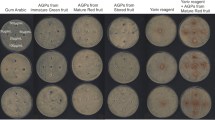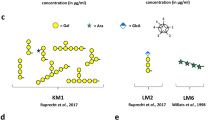Abstract
Suspension cultures of Echinacea purpurea have been established in MS medium supplemented with 2,4-D and an arabinogalactan-protein (AGP) was purified from the secreted soluble polymers by precipitation with ethanol, followed by precipitation with β-glucosyl Yariv reagent. It revealed typical features of AGPs: a high amount of polysaccharide (90% w/w) with the dominating monosaccharides galactose and arabinose and some glucuronic acid, and a small protein moiety (10% w/w) with the main amino acids Ala, Hyp, Glx, Ser, Asx and Thr. Linkage- and NMR-analyses showed the polysaccharide part to be composed of a branched core-polysaccharide of 3-, 6- and 3,6-linked Galp residues with terminal Araf, Arap, Galp and GlcAp residues. Compared to an AGP from pressed juice of the aerial parts of Echinacea purpurea, differences particularly in terminal arabinose mono- and oligosaccharides in arabinogalactan (AG) side branches could be detected. Testing of different AGP-antibodies with both AGPs confirmed the results of the analytical investigations. Binding of AGPs from plant and cell cultures to LM2, a monoclonal AGP-antibody reacting with a GlcA containing epitope, was comparable. The reactivity of a monoclonal antibody raised against the AGP from the plant recognizing a galactan epitope was also nearly similar with both AGPs. In contrast, polyclonal antibodies raised against the AGP from the plant and directed against an Araf-containing epitope of the AG side branches showed nearly no cross reactivity with the AGP from cell culture.
Similar content being viewed by others
Abbreviations
- AG:
-
Arabinogalactan
- AGP:
-
Arabinogalactan-protein
- 2,4-D:
-
2,4-Dichlorophenoxyacetic acid
- GLC–MS:
-
Gas liquid chromatography–mass spectrometry
- MS:
-
Murashige and Skoog medium (1962)
References
Alban S, Classen B, Brunner G, Blaschek W (2002) Haemolytic complement assay for the differentiation between the complement modulating effects of an arabinogalactan-protein from Echinacea purpurea and heparin. Planta Med 68:1118–1124
Aspinall GO (1982) Classification of polysaccharides. In: Aspinall GO (ed) The polysaccharides. Academic Press, New York
Bacic A, Currie G, Gilson P, Mau S-L, Oxley D, Schultz CJ, Sommer-Knudsen J, Clarke AE (2000) Structural classes of arabinogalactan-proteins. In: Nothnagel EA, Bacic A, Clarke AE (eds) Cell and developmental biology of arabinogalactan-proteins. Kluwer Academic Publishers/Plenum, Dordrecht, Netherlands/New York
Baldwin TC, McCann MC, Roberts K (1993) A novel hydroxyproline-deficient arabinogalactan-protein secreted by suspension-cultured cells of Daucus carota. Plant Physiol 103:115–123
Baldwin TC, Domingo C, Schindler T, Seetharaman G, Stacey N, Roberts K (2001) DcAGP1, a secreted arabinogalactan protein, is related to a family of basic proline-rich proteins. Plant Mol Biol 45:421–435
Bauer R (1998) The Echinacea story—the scientific development of an herbal immunostimulant. In: Prendergast HDV, Etkin NL, Harris DR, Houghton PJ (eds) Plants for food and medicine. Royal Botanic Gardens, Kew
Blakeney AB, Harris PJ, Henry RJ, Stone BA (1983) A simple and rapid preparation of alditol acetates for monosaccharide analysis. Carbohydr Res 113:291–299
Chen C-G, Pu Z-Y, Moritz RL, Simpson RJ, Bacic A, Clarke AE, Mau S-L (1994) Molecular cloning of a gene encoding an arabinogalactan-protein from pear (Pyrus communis) cell suspension culture. Proc Natl Acad Sci USA 91:10305–10309
Classen B, Witthohn K, Blaschek W (2000) Characterization of an arabinogalactan-protein isolated from pressed juice of Echinacea purpurea by precipitation with the β-glucosyl Yariv reagent. Carbohydr Res 327:497–504
Classen B, Blaschek W (2002) An arabinogalactan-protein from cell culture of Malva sylvestris. Planta Med 68:232–236
Classen B, Csávás M, Borbás A, Dingermann T, Zündorf I (2004) Monoclonal antibodies against an arabinogalactan-protein from pressed juice of Echinacea purpurea. Planta Med 70:861–865
Classen B, Mau S-L, Bacic A (2005) The arabinogalactan-proteins from pressed juice of Echinacea purpurea belong to the “hybrid” class of hydroxyproline-rich glycoproteins. Planta Med 71:59–66
Fincher GB, Stone BA, Clarke AE (1983) Arabinogalactan-proteins: structure, biosynthesis, and function. Annu Rev Plant Physiol 34:47–70
Gane AM, Craik D, Munro SLA, Howlett GJ, Clarke AE, Bacic A (1995) Structural analysis of the carbohydrate moiety of arabinogalactan-proteins from stigmas and styles of Nicotiana alata. Carbohydr Res 277:67–85
Gao M, Showalter AM (1999) Yariv treatment induces programmed cell death in Arabidopsis cell cultures and implicates arabinogalactan protein involvement. Plant J 19(3):321–331
Gaspar Y, Johnson KL, McKenna JA, Bacic A, Schultz C (2001) The complex structures of arabinogalactan-proteins and the journey towards understanding function. J Plant Mol Biol 47:161–176
Gleeson PA, Clarke AE (1979) Structural studies on the major component of Gladiolus style mucilage, an arabinogalactan-protein. Biochem J 181:607–621
Habibi Y, Mahrouz M, Marais M-F, Vignon MR (2004) An arabinogalactan from the skin of Opuntia ficus-indica prickly pear fruits. Carbohydr Res 339:1201–1205
Harris PJ, Henry RJ, Blakeney AB, Stone BA (1984) An improved procedure for the methylation analysis of oligosaccharides and polysaccharides. Carbohydr Res 127:59–73
Hoheisel O, Sandberg M, Bertram S, Bulitta M, Schäfer M (1997) Echinagard treatment shortens the course of the common cold: a double-blind, placebo-controlled clinical trial Europ. J Clin Res 9:261–268
Komalavilas P, Zhu J-K, Nothnagel EA (1991) Arabinogalactan-proteins from the suspension culture medium and plasma membrane of rose cells. J Biol Chem 266:15956–15965
Knox JP (1997) The use of antibodies to study the architecture and developmental regulation of plant cell walls. Int J Cytol 171:79–120
Kreuger M, van Holst GJ (1993) Arabinogalactan proteins are essential in somatic embryogenesis of Daucus carota L. Planta 189:243–248
Kreuger M, van Holst GJ (1995) Arabinogalactan-protein epitopes in somatic embryogenesis of Daucus carota L. Planta 197:135–141
Lohmann-Matthes ML, Wagner H (1989) Aktivierung von Makrophagen durch Polysaccharide aus Gewebekulturen von Echinacea purpurea. Z Phytother 10:52–59
Manley-Harris M (1997) Structural studies by NMR spectroscopy of the major oligomers from alkali-degraded arabinogalactan from Larix occidentalis. Carbohydr Polym 34:243–249
Mau S-L, Chen C-G, Pu Z-Y, Moritz RL, Simpson RJ, Bacic A, Clarke AE (1995) Molecular cloning of cDNAs encoding the protein backbones of arabinogalactan-proteins from the filtrate of suspension-cultured cells of Pyrus communis and Nicotiana alata. Plant J 8(2):269–281
Murashige T, Skoog F (1962) A revised medium for rapid growth and bioassays with tobacco tissue cultures. Physiol Plant 15:473–497
Nothnagel EA (1997) Proteoglycans and related components in plant cells. In: Jeon KW (ed) International review of cytology—a survey of cell biology. Academic Press, San Diego
Ponder GR, Richards GNJ (1997) Arabinogalactan from western larch, part II: a reversible order–disorder transition. J Carbohydr Chem 16(2):195–211
Saulnier L, Brillouet J-M (1988) Structural studies of pectic substances from the pulp of grape berries. Carbohydr Res 182:63–78
Serpe MD, Nothnagel EA (1994) Effects of Yariv phenylglycosides on Rosa cell suspensions: evidence for the involvement of arabinogalactan-proteins in cell proliferation. Planta 193:542–550
Serpe MD, Nothnagel EA (1995) Fractionation and characterization of arabinogalactan-proteins from the cell wall of rose cells. Plant Physiol 109:1007–1016
Sims JM, Bacic A (1995) Extracellular polysaccharides from suspension cultures of Nicotiana plumbaginifolia. Phytochem 38:1397–1405
Sims IM, Middleton K, Lane AG, Cairns AJ, Bacic A (2000) Characterisation of extracellular polysaccharides from suspension cultures of members of the Poaceae. Planta 210:261–268
Smallwood M, Yates EA, Willats WGT, Martin H, Knox JP (1996) Immunochemical comparison of membrane-associated and secreted arabinogalactan-proteins in rice and carrot. Planta 198:452–459
Stimpel M, Proksch A, Wagner H, Lohmann-Matthes ML (1984) Macrophage activation and induction of macrophage cytotoxicity by purified polysaccharide fractions from the plant Echinacea purpurea. Infect Immun 46:845–849
Taylor RL, Conrad HE (1972) Stoichiometric depolymerisation of polyuronides and glycosamino-glyuronans to monosaccharides following reduction of their carbodiimide-activated carboxyl groups. Biochemistry 11:1383–1388
Thude S, Classen B, Blaschek W, Barz D, Thude D (2006) Binding studies of an arabinogalactan-protein from Echinacea purpurea to leucocytes. Phytomedicine 13:425–427
Wagner H, Proksch A, Riess-Maurer I, Vollmar A, Odenthal S, Stuppner H, Jurcic K, Le Turdu M, Fang JN (1985) Immunstimulierend wirkende Polysaccharide (Heteroglykane) aus höheren Pflanzen. Drug Res 35:1069–1075
Wagner H, Stuppner H, Schäfer W, Zenk MA (1988) Immunologically active polysaccharides of Echinacea purpurea cell cultures. Phytochemistry 27:119–126
Wagner H, Stuppner H, Puhlmann J, Brümmer B, Deppe K, Zenk MA (1989) Isolation of immunologically active polysaccharides from Echinacea-drugs and tissue culture. Z Phytother 10:35–38
Yariv J, Rapport MM, Graf L (1962) The interaction of glycosides and saccharides with antibody to the corresponding phenylazo glycosides. Biochem J 85:383–388
Youl JJ, Bacic A, Oxley D (1998) Arabinogalactan-proteins from Nicotiana alata and Pyrus communis contain glycosylphosphatidylinositol membrane anchors. Proc Natl Acad Sci USA 95:7921–7926
Zhu J-K, Bressan RA, Hasegawa PM (1993) Loss of arabinogalactan-proteins from the plasma membrane of NaCl-adapted tobacco cells. Planta 190:221–226
Acknowledgements
Thanks to F. Rodde for technical assistance, to Dr. I. Zündorf, Frankfurt, Germany, for generation of the monoclonal antibody against Echinacea AGP and to Prof. P. Knox, Leeds, and Prof. K. Roberts, Norwich, UK, for providing LM 2.
Author information
Authors and Affiliations
Corresponding author
Rights and permissions
About this article
Cite this article
Classen, B. Characterization of an arabinogalactan-protein from suspension culture of Echinacea purpurea . Plant Cell Tiss Organ Cult 88, 267–275 (2007). https://doi.org/10.1007/s11240-006-9197-9
Received:
Accepted:
Published:
Issue Date:
DOI: https://doi.org/10.1007/s11240-006-9197-9




